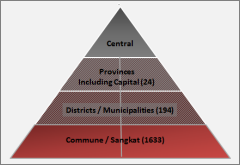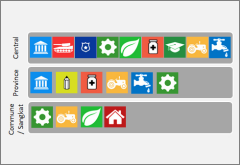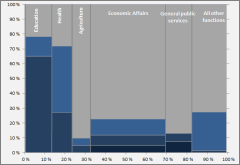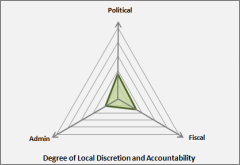Country Profile Background
Decentralization and Deconcentration (D and D) has been one of the main reforms pursued by the government of Cambodia as part of the post-conflict democratization process since the mid-1990. The first serious steps towards decentralization in Cambodia were taken in 2001-02 with the passing of the Commune Law; the election of 1,621 Commune Councils and the introduction of the Commune-Sangkat Fund. In 2005, the country adopted the Strategic Framework for Decentralization and Deconcentration Reform, which was followed by the Law on Administrative Management of the Capital, Province, Municipality, District and Khan (widely known
as the Organic Law) in 2008. Although the Organic Law forms a key element of the legal framework for implementing the Strategic Framework, the full implementation of the law will require a long-term process of capacity building and institutional reform. Overall, the ongoing reforms are creating a hybrid public sector which is largely focused on the deconcentration of functions and authorities, but with some elements of devolution.
Organizational/Governance Structure of the Public Sector
The first major step towards democratic, decentralized management at local levels was made in 2001, when the Law on Commune and Sangkat Administrative Management (2001) recognized communes and sangkats as local government entities with their own directly elected leadership and legislative and executive powers. In 2008, the Organic Law provided the administrative basis for further deconcentration and decentralization by formalizing the structures and roles of the provincial level (including provinces and the capital) as well as a district level (covering provincial districts as well as municipalities). There are some differences between the organizational-governance arrangements for urban versus rural jurisdictions, while the Capital, Phnom Penh, has its own unique administrative structure.
Although the district level has the potential to become an effective local government level, district-level jurisdictions are currently only nascent local government entities. By law, provincial and district-level jurisdictions have indirectly elected councils; councils at these higher levels are elected from the bottom up by Commune Council members within their respective jurisdictions. Although the Organic Law envisions subnational councils to have broad roles, duties, and the authority to make legislative and executive decisions, for the time being, provinces basically continue to operate as deconcentrated entities.
Functional Responsibilities of the Local Public Sector
Although roles and functions of different tiers of government are not well defined by law, de facto functional assignments in Cambodia’s public sector are quite centralized. In practice, Communes and Sangkats focus largely on providing community-level infrastructure and services. As such, the provincial level is de facto the only functioning subnational administrative level, with responsibility for the delivery of key front-line social services, such as basic education, health services, agricultural extension, and so on. Even in these functional areas, however, central line ministries often retain the responsibility (and resources) for development expenditures, although provincial governors have a small discretionary cross-sectoral budget at their disposal (the provincial salakhet) to promote provincial development.
Fiscal Profile of the Public Sector
The national budget is vertically (sectorally) deconcentrated up to the provincial level: line ministry budgets identify central line department expenditures separately from provincial line department expenditures (including salakhet expenditures). In addition, the national budget reports on the size of the Commune-Sangkat Fund and the District Development Fund. There is no systematic reporting of district- or commune-level revenues or expenditures.
Only about one-third (33.4 percent) of total public expenditures fall within the local public sector. This amount includes about 15 percent of total public sector expenditures which take place in a deconcentrated manner at the provincial level. In addition, central government spending on ‘local’ services accounts for another 15 percent of public spending. Only about 2 percent of public sector expenditures in Cambodia take place at the commune level, whereas district-expenditures account for less than 1 percent of public sector spending. The remainder of public expenditures (66.6 percent) is retained at the central government level for national functions and central government administration.
Institutional Profile of the Local Public Sector
Despite the ongoing reforms, the central government continues to retain a high degree of top-down political, administrative and fiscal control over the local public sector in Cambodia. For instance, although provincial officials have some degree of de facto discretion over the delivery of public services within their jurisdiction, provinces lack their own political leadership, have only limited administrative discretion, and rely almost exclusively on financial resources received from the center. Even though Communes have directly elected Councils (see graph), the degree of responsibility, discretion and accountability at this level is also quite limited.
Country Profile Information
Complete LPS Country Profile: Cambodia (PDF)
Complete LPS Country Profile: Cambodia (XLS)





